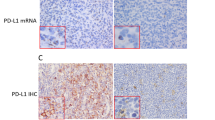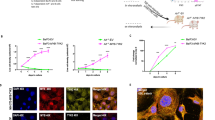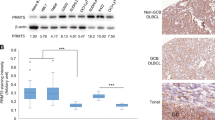Abstract
Dysregulation of the oncogenic transcription factor MYC induces B-cell transformation and is a driver for B-cell non-Hodgkin lymphoma (B-NHL). MYC overexpression in B-NHL is associated with more aggressive phenotypes and poor prognosis. Although genomic studies suggest a link between MYC overexpression and B-cell receptor (BCR) signaling molecules in B-NHL, signaling pathways essential to Myc-mediated B-cell transformation have not been fully elucidated. We utilized intracellular phospho-flow cytometry to investigate the relationship between Myc and BCR signaling in pre-malignant B cells. Utilizing the Eμ-myc mouse model, where Myc is overexpressed specifically in B cells, both basal and stimulated BCR signaling were increased in precancerous B lymphocytes from Eμ-myc mice compared with wild-type littermates. B cells overexpressing Myc displayed constitutively higher levels of activated CD79α, Btk, Plcγ2 and Erk1/2. Notably, Myc-overexpressing B cells maintained elevated BCR signaling despite treatment with ibrutinib, a Bruton’s tyrosine kinase inhibitor. Furthermore, PI3K/Akt pathway signaling was also increased in Eμ-myc B cells, and this increase was partially suppressed with ibrutinib. In addition, experiments with Btk-null B cells revealed off-target effects of ibrutinib on BCR signaling. Our data show that in pre-malignant B cells, Myc overexpression is sufficient to activate BCR and PI3K/Akt signaling pathways and further enhances signaling following BCR ligation. Therefore, our results indicate that precancerous B cells have already acquired enhanced survival and growth capabilities before transformation, and that elevated MYC levels confer resistance to pharmacologic inhibitors of BCR signaling, which has significant implications for B-NHL treatment.
This is a preview of subscription content, access via your institution
Access options
Subscribe to this journal
Receive 50 print issues and online access
$259.00 per year
only $5.18 per issue
Buy this article
- Purchase on Springer Link
- Instant access to full article PDF
Prices may be subject to local taxes which are calculated during checkout






Similar content being viewed by others
References
Xu X, Zhang L, Wang Y, Zhang Q, Zhang L, Sun B et al. Double-hit and triple-hit lymphomas arising from follicular lymphoma following acquisition of MYC: report of two cases and literature review. Int J Clin Exp Pathol 2013; 6: 788–794.
Young KH, Xie Q, Zhou G, Eickhoff JC, Sanger WG, Aoun P et al. Transformation of follicular lymphoma to precursor B-cell lymphoblastic lymphoma with c-myc gene rearrangement as a critical event. Am J Clin Pathol 2008; 129: 157–166.
Christie L, Kernohan N, Levison D, Sales M, Cunningham J, Gillespie K et al. C-MYC translocation in t(14;18) positive follicular lymphoma at presentation: an adverse prognostic indicator? Leuk Lymphoma 2008; 49: 470–476.
Huh YO, Lin KI, Vega F, Schlette E, Yin CC, Keating MJ et al. MYC translocation in chronic lymphocytic leukaemia is associated with increased prolymphocytes and a poor prognosis. Br J Haematol 2008; 142: 36–44.
Adams JM, Harris AW, Pinkert CA, Corcoran LM, Alexander WS, Cory S et al. The c-myc oncogene driven by immunoglobulin enhancers induces lymphoid malignancy in transgenic mice. Nature 1985; 318: 533–538.
Sampson VB, Rong NH, Han J, Yang Q, Aris V, Soteropoulos P et al. MicroRNA let-7a down-regulates MYC and reverts MYC-induced growth in Burkitt lymphoma cells. Cancer Res 2007; 67: 9762–9770.
Felsher DW, Bishop JM . Reversible tumorigenesis by MYC in hematopoietic lineages. Mol Cell 1999; 4: 199–207.
Kraus M, Alimzhanov MB, Rajewsky N, Rajewsky K . Survival of resting mature B lymphocytes depends on BCR signaling via the Igalpha/beta heterodimer. Cell 2004; 117: 787–800.
Lam KP, Kuhn R, Rajewsky K . In vivo ablation of surface immunoglobulin on mature B cells by inducible gene targeting results in rapid cell death. Cell 1997; 90: 1073–1083.
Pede V, Rombout A, Vermeire J, Naessens E, Mestdagh P, Robberecht N et al. CLL cells respond to B-Cell receptor stimulation with a microRNA/mRNA signature associated with MYC activation and cell cycle progression. PLoS One 2013; 8: e60275.
Yeomans A, Thirdborough SM, Valle-Argos B, Linley A, Krysov S, Hidalgo MS et al. Engagement of the B-cell receptor of chronic lymphocytic leukemia cells drives global and MYC-specific mRNA translation. Blood 2016; 127: 449–457.
Woyach JA, Johnson AJ, Byrd JC . The B-cell receptor signaling pathway as a therapeutic target in CLL. Blood 2012; 120: 1175–1184.
Beitz LO, Fruman DA, Kurosaki T, Cantley LC, Scharenberg AM . SYK is upstream of phosphoinositide 3-kinase in B cell receptor signaling. J Biol Chem 1999; 274: 32662–32666.
Davis RE, Ngo VN, Lenz G, Tolar P, Young RM, Romesser PB et al. Chronic active B-cell-receptor signalling in diffuse large B-cell lymphoma. Nature 2010; 463: 88–92.
Shaffer AL 3rd, Young RM, Staudt LM . Pathogenesis of human B cell lymphomas. Annu Rev Immunol 2012; 30: 565–610.
Schmitz R, Young RM, Ceribelli M, Jhavar S, Xiao W, Zhang M et al. Burkitt lymphoma pathogenesis and therapeutic targets from structural and functional genomics. Nature 2012; 490: 116–120.
Advani RH, Buggy JJ, Sharman JP, Smith SM, Boyd TE, Grant B et al. Bruton tyrosine kinase inhibitor ibrutinib (PCI-32765) has significant activity in patients with relapsed/refractory B-cell malignancies. J Clin Oncol 2013; 31: 88–94.
Wang ML, Rule S, Martin P, Goy A, Auer R, Kahl BS et al. Targeting BTK with ibrutinib in relapsed or refractory mantle-cell lymphoma. N Engl J Med 2013; 369: 507–516.
Byrd JC, Furman RR, Coutre SE, Flinn IW, Burger JA, Blum KA et al. Targeting BTK with ibrutinib in relapsed chronic lymphocytic leukemia. N Engl J Med 2013; 369: 32–42.
Li Z, Van Calcar S, Qu C, Cavenee WK, Zhang MQ, Ren B . A global transcriptional regulatory role for c-Myc in Burkitt's lymphoma cells. Proc Natl Acad Sci USA 2003; 100: 8164–8169.
Psathas JN, Doonan PJ, Raman P, Freedman BD, Minn AJ, Thomas-Tikhonenko A . The Myc-miR-17-92 axis amplifies B-cell receptor signaling via inhibition of ITIM proteins: a novel lymphomagenic feed-forward loop. Blood 2013; 122: 4220–4229.
Dal Porto JM, Gauld SB, Merrell KT, Mills D, Pugh-Bernard AE, Cambier J . B cell antigen receptor signaling 101. Mol Immunol 2004; 41: 599–613.
Meng TC, Fukada T, Tonks NK . Reversible oxidation and inactivation of protein tyrosine phosphatases in vivo. Mol Cell 2002; 9: 387–399.
Baba Y, Hashimoto S, Matsushita M, Watanabe D, Kishimoto T, Kurosaki T et al. BLNK mediates Syk-dependent Btk activation. Proc Natl Acad Sci USA 2001; 98: 2582–2586.
Pan Z, Scheerens H, Li SJ, Schultz BE, Sprengeler PA, Burrill LC et al. Discovery of selective irreversible inhibitors for Bruton's tyrosine kinase. ChemMedChem 2007; 2: 58–61.
Khan WN, Alt FW, Gerstein RM, Malynn BA, Larsson I, Rathbun G et al. Defective B cell development and function in Btk-deficient mice. Immunity 1995; 3: 283–299.
Satterthwaite AB, Cheroutre H, Khan WN, Sideras P, Witte ON . Btk dosage determines sensitivity to B cell antigen receptor cross-linking. Proc Natl Acad Sci USA 1997; 94: 13152–13157.
Ding J, Takano T, Gao S, Han W, Noda C, Yanagi S et al. Syk is required for the activation of Akt survival pathway in B cells exposed to oxidative stress. J Biol Chem 2000; 275: 30873–30877.
Refaeli Y, Young RM, Turner BC, Duda J, Field KA, Bishop JM . The B cell antigen receptor and overexpression of MYC can cooperate in the genesis of B cell lymphomas. PLoS Biol 2008; 6: e152.
Gramling MW, Eischen CM . Suppression of Ras/Mapk pathway signaling inhibits Myc-induced lymphomagenesis. Cell Death Differ 2012; 19: 1220–1227.
Love C, Sun Z, Jima D, Li G, Zhang J, Miles R et al. The genetic landscape of mutations in Burkitt lymphoma. Nat Genet 2012; 44: 1321–1325.
Richter J, Schlesner M, Hoffmann S, Kreuz M, Leich E, Burkhardt B et al. Recurrent mutation of the ID3 gene in Burkitt lymphoma identified by integrated genome, exome and transcriptome sequencing. Nat Genet 2012; 44: 1316–1320.
Ponader S, Chen SS, Buggy JJ, Balakrishnan K, Gandhi V, Wierda WG et al. The Bruton tyrosine kinase inhibitor PCI-32765 thwarts chronic lymphocytic leukemia cell survival and tissue homing in vitro and in vivo. Blood 2012; 119: 1182–1189.
Honigberg LA, Smith AM, Sirisawad M, Verner E, Loury D, Chang B et al. The Bruton tyrosine kinase inhibitor PCI-32765 blocks B-cell activation and is efficacious in models of autoimmune disease and B-cell malignancy. Proc Natl Acad Sci USA 2010; 107: 13075–13080.
Byrd JC, Harrington B, O'Brien S, Jones JA, Schuh A, Devereux S et al. Acalabrutinib (ACP-196) in relapsed chronic lymphocytic leukemia. N Engl J Med 2016; 374: 323–332.
Kurosaki T, Johnson SA, Pao L, Sada K, Yamamura H, Cambier JC . Role of the Syk autophosphorylation site and SH2 domains in B cell antigen receptor signaling. J Exp Med 1995; 182: 1815–1823.
Geahlen RL . Syk and pTyr'd: Signaling through the B cell antigen receptor. Biochim Biophys Acta 2009; 1793: 1115–1127.
Chen L, Monti S, Juszczynski P, Daley J, Chen W, Witzig TE et al. SYK-dependent tonic B-cell receptor signaling is a rational treatment target in diffuse large B-cell lymphoma. Blood 2008; 111: 2230–2237.
Bye AP, Unsworth AJ, Vaiyapuri S, Stainer AR, Fry MJ, Gibbins JM . Ibrutinib inhibits platelet integrin alphaIIbbeta3 outside-in signaling and thrombus stability but not adhesion to collagen. Arterioscler Thromb Vasc Biol 2015; 35: 2326–2335.
Manne BK, Badolia R, Dangelmaier C, Eble JA, Ellmeier W, Kahn M et al. Distinct pathways regulate Syk protein activation downstream of immune tyrosine activation motif (ITAM) and hemITAM receptors in platelets. J Biol Chem 2015; 290: 11557–11568.
Speich HE, Grgurevich S, Kueter TJ, Earhart AD, Slack SM, Jennings LK . Platelets undergo phosphorylation of Syk at Y525/526 and Y352 in response to pathophysiological shear stress. Am J Physiol Cell Physiol 2008; 295: C1045–C1054.
Irish JM, Czerwinski DK, Nolan GP, Levy R . Kinetics of B cell receptor signaling in human B cell subsets mapped by phosphospecific flow cytometry. J Immunol 2006; 177: 1581–1589.
Acknowledgements
We thank Dr Peggy Kendall for providing Btk−/− mice and members of the Eischen laboratory and Dr Jonathan Irish for their advice. This work was supported by NIH/NCI R21CA184352 (CME), the Hematology Helping Hands Research Award (TKM) and the NCI Cancer Center support grant P30CA68485 that supports the Vanderbilt Flow Cytometry Shared Resource and the NCI Cancer Center support grant P30CA056036.
Author information
Authors and Affiliations
Corresponding author
Ethics declarations
Competing interests
The authors declare no conflict of interest.
Additional information
Supplementary Information accompanies this paper on the Oncogene website
Supplementary information
Rights and permissions
About this article
Cite this article
Moyo, T., Wilson, C., Moore, D. et al. Myc enhances B-cell receptor signaling in precancerous B cells and confers resistance to Btk inhibition. Oncogene 36, 4653–4661 (2017). https://doi.org/10.1038/onc.2017.95
Received:
Revised:
Accepted:
Published:
Issue Date:
DOI: https://doi.org/10.1038/onc.2017.95
This article is cited by
-
Phosphoflow cytometry to assess cytokine signaling pathways in peripheral immune cells: potential for inferring immune cell function and treatment response in patients with solid tumors
Journal of Experimental & Clinical Cancer Research (2023)
-
MYC: a multipurpose oncogene with prognostic and therapeutic implications in blood malignancies
Journal of Hematology & Oncology (2021)
-
The BET inhibitor GS-5829 targets chronic lymphocytic leukemia cells and their supportive microenvironment
Leukemia (2020)
-
Aberrantly expressed Bruton’s tyrosine kinase preferentially drives metastatic and stem cell-like phenotypes in neuroblastoma cells
Cellular Oncology (2020)
-
Bruton’s tyrosine kinase is at the crossroads of metabolic adaptation in primary malignant human lymphocytes
Scientific Reports (2019)



